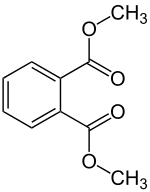Dimethyl phthalate
Dimethyl phthalate is an organic compound with molecular formula (C2H3O2)2C6H4. The methyl ester of phthalic acid, it is a colorless liquid that is soluble in organic solvents.
 | |
| Names | |
|---|---|
| Preferred IUPAC name
Dimethyl benzene-1,2-dicarboxylate | |
| Other names
Dimethyl phthalate | |
| Identifiers | |
CAS Number |
|
3D model (JSmol) |
|
| ChEMBL | |
| ChemSpider | |
| ECHA InfoCard | 100.004.557 |
| KEGG | |
PubChem CID |
|
| UNII | |
CompTox Dashboard (EPA) |
|
InChI
| |
SMILES
| |
| Properties | |
Chemical formula |
C10H10O4 |
| Molar mass | 194.184 g/mol |
| Appearance | Colorless oily liquid |
| Odor | slight aromatic odor[2] |
| Density | 1.19 g/cm3 |
| Melting point | 2 °C (36 °F; 275 K) |
| Boiling point | 283 to 284 °C (541 to 543 °F; 556 to 557 K) |
Solubility in water |
0.4% (20°C)[2] |
| Vapor pressure | 0.01 mmHg (20°C)[2] |
| Pharmacology | |
| P03BX02 (WHO) QP53GX02 (WHO) | |
| Hazards | |
| Flash point | 146 °C (295 °F; 419 K) |
Autoignition temperature |
460 °C (860 °F; 733 K) |
| Explosive limits | 0.9%-?[2] |
| Lethal dose or concentration (LD, LC): | |
LD50 (median dose) |
6900 mg/kg (rat, oral) 1000 mg/kg (rabbit, oral) 2400 mg/kg (guinea pig, oral) 6800 mg/kg (rat, oral) 6800 mg/kg (mouse, oral) 4400 mg/kg (rabbit, oral) 2400 mg/kg (guinea pig, oral)[3] |
LCLo (lowest published) |
9630 mg/m3[3] |
| NIOSH (US health exposure limits): | |
PEL (Permissible) |
TWA 5 mg/m3[2] |
REL (Recommended) |
TWA 5 mg/m3[2] |
IDLH (Immediate danger) |
2000 mg/m3[2] |
Except where otherwise noted, data are given for materials in their standard state (at 25 °C [77 °F], 100 kPa). | |
| Infobox references | |
Dimethyl phthalate is used as an insect repellent for mosquitoes and flies. It is also an ectoparasiticide and has many other uses, including in solid rocket propellants, and plastics. Its LD50 is 8200 mg/kg (rats, oral).[4]
References
- Dimethyl phthlate at chemicalland21.com
- NIOSH Pocket Guide to Chemical Hazards. "#0228". National Institute for Occupational Safety and Health (NIOSH).
- "Dimethylphthalate". Immediately Dangerous to Life and Health Concentrations (IDLH). National Institute for Occupational Safety and Health (NIOSH).
- Robert L. Metcalf “Insect Control” in Ullmann’s Encyclopedia of Industrial Chemistry” Wiley-VCH, Weinheim, 2002. doi:10.1002/14356007.a14_263
This article is issued from
Wikipedia.
The text is licensed under Creative
Commons - Attribution - Sharealike.
Additional terms may apply for the media files.